Torrieri D. Principles of Spread-Spectrum Communication Systems
Подождите немного. Документ загружается.

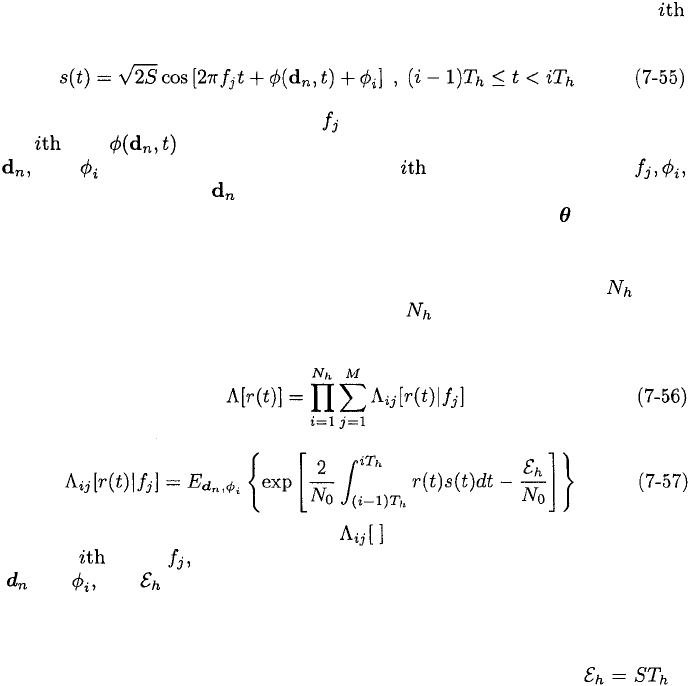
398
CHAPTER 7. DETECTION OF SPREAD-SPECTRUM SIGNALS
termining whether one or more than one signal has been detected, narrowband
interference can be rejected by the methods of Section 2.7.
7.2
Detection of Frequency-Hopping Signals
An interception receiver intended for the detection of frequency-hopping signals
may be designed according to the principles of classical detection theory or
according to more intuitive ideas. The former approach is useful in setting
limits on what is possible, but the latter approach is more practical and flexible
and less dependent on knowledge of the characteristics of the frequency-hopping
signals.
Ideal Detection
To enable a tractable analysis, the idealized assumptions are made that the
hopset is known and that the hop epoch timing, which includes the hop-
transition times is known. Consider slow frequency-hopping signals with CPM
(FH/CPM), which includes continuous-phase MFSK. The signal over the
hop interval is
where S is the average signal power, is the carrier frequency associated with
the hop, is the CPM component that depends on the data sequence
and is the phase associated with the hop. The parameters
and the components of are modeled as random variables. The derivation
of the average likelihood ratio (7-7) is still valid, but the vector has different
parameters as components.
The M carrier frequencies in the hopset are assumed to be equally likely
over a given hop and statistically independent from hop to hop for hops.
Dividing the integration interval in (7-7) into parts, averaging over the M
frequencies, and dropping the irrelevant factor 1/
M
, we obtain
where the condition in the argument of indicates that the carrier frequency
over the hop is the expectation is over the remaining random parameters
and and is the energy per hop. The decomposition in (7-56) indicates
that the general structure of the detector has the form illustrated in Figure 7.4.
The average likelihood ratio of (7-56) is compared with a threshold to determine
whether a signal is present. The threshold may be set to ensure the tolerable
false-alarm probability when the signal is absent. Assuming that is

7.2.
DETECTION OF FREQUENCY-HOPPING SIGNALS
399
Figure 7.4: General structure of optimum detector for frequency-hopping signal
with hops and M frequency channels.
the same for every hop and carrier frequency, we may drop the irrelevant factor
in (7-57), which only affects the threshold level.
Each of the data sequences that can occur during a hop is assumed to be
equally likely. For coherent detection of FH/CPM [5], we set in (7-55),
substitute it into (7-57), and then evaluate the expectation to obtain
where irrelevant factors have been dropped. This equation indicates how
in Figure 7.4 is to be calculated for each hop and each frequency channel
corresponding to carrier frequency Equations (7-56) and (7-58) define the
optimum coherent detector for any slow frequency-hopping signal with CPM.
For noncoherent detection of FH/CPM [4], the received carrier phase is
assumed to be uniformly distributed over during a given hop and statis-
tically independent from hop to hop. Substituting (7-55) into (7-57), averaging
over the random phase in addition to the sequence statistics, and dropping
irrelevant factors yields
where
and
Equations (7-56), (7-59), (7-60), and (7-61) define the optimum noncoherent
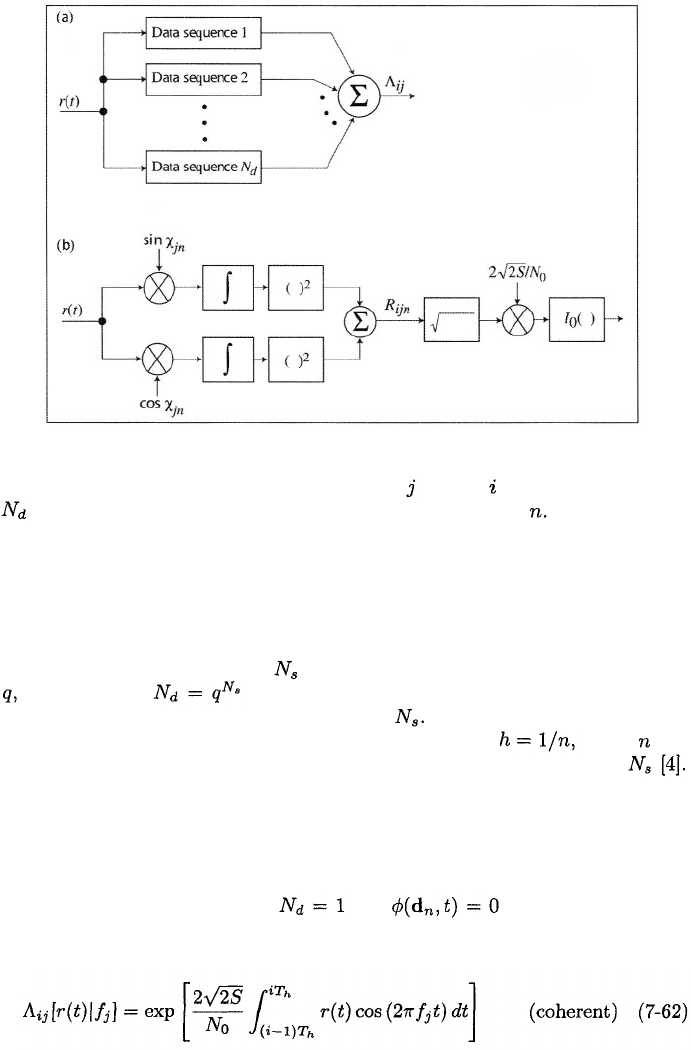
400
CHAPTER 7. DETECTION OF SPREAD-SPECTRUM SIGNALS
Figure 7.5: Optimum noncoherent detector for slow frequency hopping with
CPM: (a) basic structure of frequency channel for hop with parallel cells for
candidate data sequences, and (b) cell for data sequence
detector for any slow frequency-hopping signal with CPM. The means of pro-
ducing (7-59) is diagrammed in Figure 7.5.
A major contributor to the huge computational complexity of the optimum
detectors is the fact that with data symbols per hop and an alphabet size
there may be data sequences per hop. Consequently, the com-
putational burden grows exponentially with However, if it is known that
the data modulation is CPFSK with a modulation index where is a
positive integer, the computational burden has a linear dependence on
Even then, the optimum detectors are extremely complex when the number of
frequency channels is large.
The preceding theory may be adapted to the detection of fast frequency-
hopping signals with MFSK as the data modulation. Since there is one hop per
MFSK channel symbol, the information is embedded in the sequence of carrier
frequencies. Thus, we may set and in (7-58) and (7-59).
For coherent detection, (7-58) reduces to
Equations (7-56) and (7-62) define the optimum coherent detector for a fast
frequency-hopping signal with MFSK. For noncoherent detection, (7-59), (7-60),
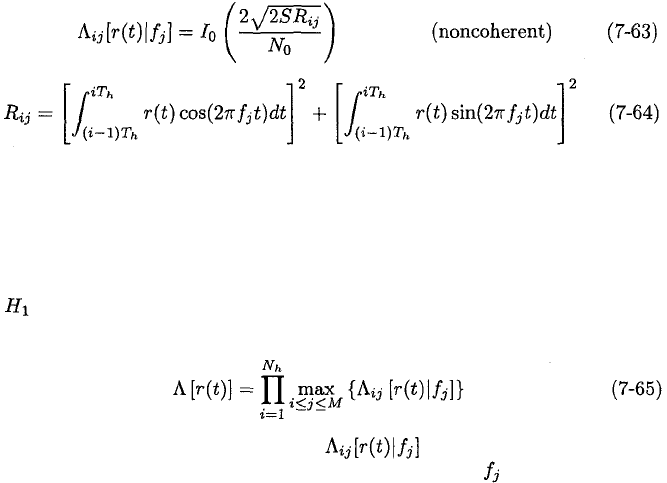
7.2.
DETECTION OF FREQUENCY-HOPPING SIGNALS
401
and (7-61) reduce to
Equations (7-56), (7-63), and (7-64) define the optimum noncoherent detector
for a fast frequency-hopping signal with MFSK. Performance analyses for the
detectors of fast frequency-hopping signals are given in [5].
Instead of basing detector design on the average likelihood ratio, one might
apply a composite hypothesis test in which the presence of the signal is detected
while simultaneously one or more of the unknown parameters under hypothe-
sis are estimated. To simultaneously detect the signal and determine the
frequency-hopping pattern, (7-56) is replaced by the generalized likelihood ratio:
where the equations and subsystems for remain the same. Equation
(7-65) indicates that a maximum-likelihood estimate of is made for each
hop. Thus, an optimum test to determine the frequency channel occupied
by the frequency-hopping signal is conducted during each hop. Although the
detection performance is suboptimal when the generalized likelihood ratio is
used to design a detector, this detector provides an important signal feature
and is slightly easier to implement and analyze [4], [5].
Wideband Radiometer
Among the many alternatives to the optimum detector, two of the most useful
are the wideband radiometer and the channelized radiometer. The wideband
radiometer is notable in that it requires virtually no detailed information about
the parameters of the frequency-hopping signals to be detected other than their
rough spectral location. The price paid for this robustness is much worse per-
formance than more sophisticated detectors that exploit additional information
about the signal [4]. The channelized radiometer is designed to explicitly ex-
ploi
t
the spectral characteristics of frequency-hopping signals. In its optimal
form, the channelized radiometer gives a performance nearly as good as that of
th
e
ideal detector. In its suboptimal form, the channelized radiometer trades
performance for practicality and the easing of the required a priori information
about the signal to be detected.
Channelized Radiometer
A channelized radiometer comprises K parallel radiometers, each of which has
the form of Figure 7.1 and monitors a disjoint portion of the hopping band of a
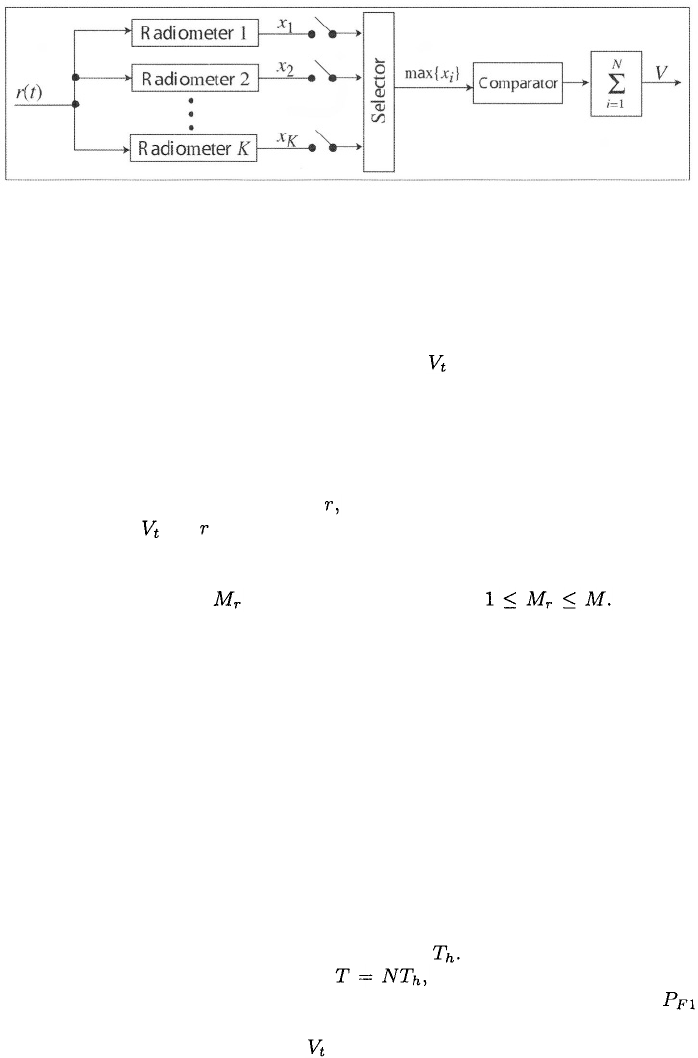
402
CHAPTER 7. DETECTION OF SPREAD-SPECTRUM SIGNALS
Figure 7.6: Channelized radiometer.
frequency-hopping signal, as depicted in Figure 7.6. The largest of the sampled
radiometer outputs is compared to a threshold stored in a comparator. If
the threshold is exceeded, the comparator sends a 1 to the summer; otherwise
it sends a 0. If the hop dwell epochs are at least approximately known, the
channelized radiometer may improve its detection reliability by adding the 1’s
produced by N consecutive comparator outputs corresponding to multiple fre-
quency hops of the signal to be detected. A signal is declared to be present if the
sum V equals or exceeds the integer which serves as a second threshold. The
two thresholds are are jointly optimized for the best system performance.
Ideally, K = M, the number of frequency channels in a hopset, but many
fewer radiometers may be a practical or economic necessity; if so, each ra-
diometer may monitor frequency channels, where Because
of insertion losses and the degradation caused by a power divider, it is unlikely
that many more than 30 parallel radiometers are practical. An advantage of
each radiometer covering many frequency channels is the reduced sensitivity to
imprecise knowledge of the spectral boundaries of frequency channels. Since it
is highly desirable to implement the parallel radiometers with similar circuitry,
their bandwidths are assumed to be identical henceforth.
To prevent steady interference in a single radiometer from causing false
alarms, the channelized radiometer must be able to recognize when one of its
constituent radiometers produces an output above the threshold for too many
consecutive samples. The channelized system may then delete that constituent
radiometer’s output from the detection algorithm or it may reassign the ra-
diometer to another spectral location.
In the subsequent analysis of the channelized radiometer of Figure 7.6, the
observation interval of the parallel radiometers, which is equal to the sampling
interval, is assumed to equal the hop duration The effective observation
time of the channelized radiometer, should be less than the mini-
mum expected message duration to avoid processing extraneous noise. Let
denote the probability that a particular radiometer output at the sampling time
exceeds the comparator threshold when no signal is present. This probability
is given by the right-hand side of (7-42). Therefore, a derivation similar to that
of (7-47) indicates that if the sampling times are aligned with the frequency
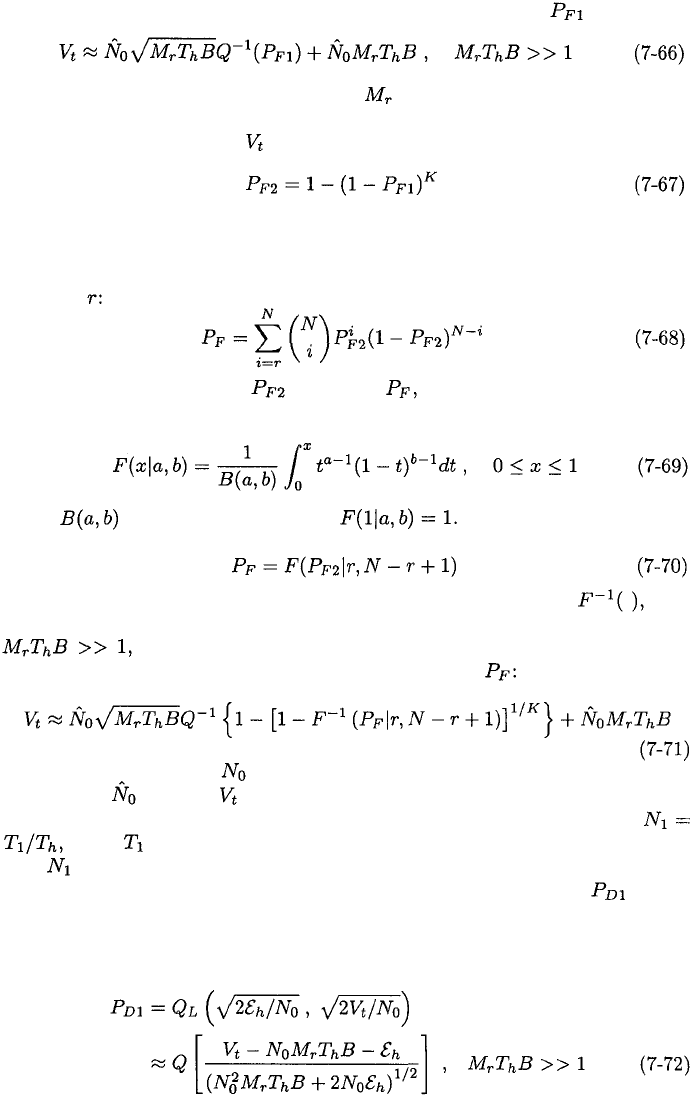
7.2.
DETECTION OF FREQUENCY-HOPPING SIGNALS
403
transitions, then the threshold necessary to achieve a specified is
where B is the bandwidth of each of the frequency channels encompassed
by a radiometer passband. The probability that at least one of the K parallel
radiometer outputs exceeds is
assuming that the channel noises are statistically independent because the ra-
diometer passbands are disjoint. The probability of a false alarm of the chan-
nelized radiometer is the probability that the output V equals or exceeds a
threshold
To solve this equation for in terms of we observe that the incomplete
beta function is defined as
where is the beta function and In terms of this function,
(7-68) becomes
The inverse of the incomplete beta function, which we denote by may
be easily computed by Newton’s method or approximations [6]. Therefore, if
(7-66), (7-67), and (7-70) may be combined to determine the
approximate threshold necessary to achieve a specified
where it is assumed that does not vary across the hopping band and, hence,
there is one and one for all the parallel radiometers.
The number of sampling intervals during which the signal is present is
where is the intercepted signal duration. For simplicity, it is assumed
that is an integer. Furthermore, we assume that at most a single radiometer
receives significant signal energy during each sampling interval. Let denote
the probability that a particular radiometer output exceeds the threshold when
a signal is present in that radiometer. Derivations similar to those of (7-45)
and (7-49) 38.88 imply that
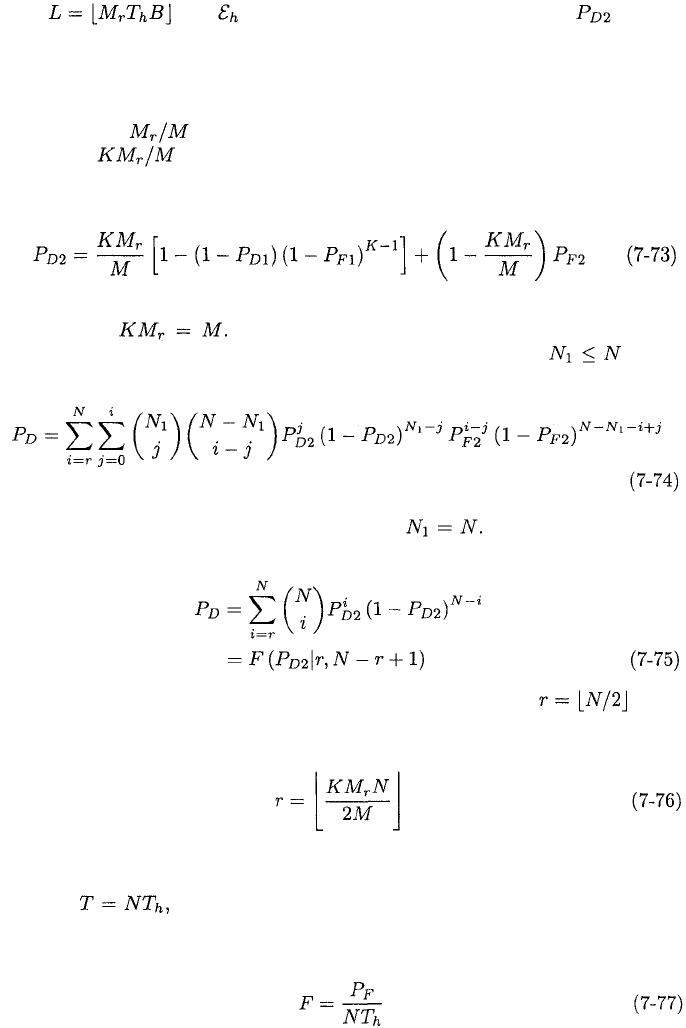
404
CHAPTER 7.
DETECTION OF SPREAD-SPECTRUM SIGNALS
where and is the energy per hop dwell time. Let denote
the probability that the threshold is exceeded by the sampled maximum of
the parallel radiometer outputs. It is assumed that when a signal is present it
occupies any one of M frequency channels with equal probability and that all
radiometer passbands are within the hopping band. Consequently, the signal
has probability of being in the passband of a particular radiometer and
probability of being in the passband of some radiometer. Since a
detection may be declared in response to a radiometer that does not receive the
signal,
where the second term vanishes if the radiometer passbands cover the hopping
band so that The probability of detection associated with the
observation interval when the signal is actually present during of the
hop intervals is
If at least the minimum duration of a frequency-hopping signal is known, the
overestimation of N might be avoided so that The detection proba-
bility then becomes
A suitable, but not optimal, choice for the second threshold is when
the full hopping band is monitored by the channelized radiometer. In general,
numerical results indicate that
is a good choice for partial-band monitoring.
If detection decisions are made in terms of fixed observation intervals of
duration and successive intervals do not overlap except possibly at
end points, then the false alarm rate defined in (7-48) is an appropriate design
parameter. This type of detection is called block detection, and the false-alarm
rate is
To prevent the risk of major misalignment of the observation interval with the
time the signal is being transmitted, either block detection must be supple-
mented with hardware for arrival-time estimation or the duration of successive
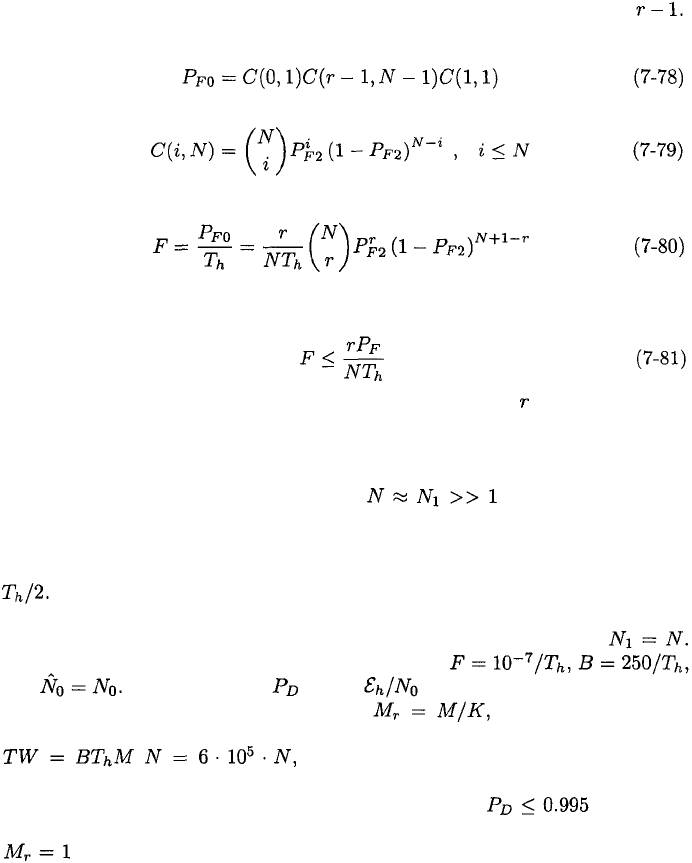
7.2.
DETECTION OF FREQUENCY-HOPPING SIGNALS
405
observation intervals should be less than roughly half the anticipated signal
duration.
A different approach to mitigating the effect of a misalignment, called binary
moving-window detection, is for the observation interval to be constructed by
dropping the first sampling interval of the preceding observation interval and
adding a new sampling interval. A false alarm is considered to be a detection
declaration at the end of the new interval when no signal is actually present.
Thus, a false alarm occurs only if the comparator input for an added sampling
interval exceeds the threshold, the comparator input for the discarded sampling
interval did not, and the count for the preceding observation interval was
Therefore, the probability of a false alarm is
where
It follows that the false-alarm rate is
Since the right-hand side of this equation is proportional to the first term of
the series in (7-68),
This inequality indicates that the false alarm rate is nearly times as large for
moving-window detection as it is for block detection. Thus, moving-window
detection usually requires a higher comparator threshold for the same false-
alarm rate and, hence, more signal power to detect a frequency-hopping signal.
However, moving-window detection with inherently limits the
misalignment between the occurrence of the intercepted signal and some obser-
vation interval. If the signal occurs during two successive obsevation intervals,
then for one of the observation intervals, the misalignment is not more than
As an example, it is assumed that there are M = 2400 frequency channels,
the signal duration is known, and there is no misalignment so that
Block detection is used so that (7-77) is applicable,
and Figure 7.7 plots versus for the channelized radiometer
with full hopping-band coverage so that and several values of
K and N. The figure also shows the results for a wideband radiometer with
and N = 150 or 750. It is observed that
the channelized radiometer with K = 30 is much better than the wideband
radiometer when N = 150, but loses its advantage for when N =
750. The substantial advantage of the channelized radiometer with K = M and
is apparent. As N increases, the channelized radiometer can retain its
advantage over the wideband radiometer by increasing K accordingly.

406
CHAPTER 7. DETECTION OF SPREAD-SPECTRUM SIGNALS
Figure 7.7: Probability of detection versus for channelized and wideband
radiometers with full coverage,
and
Figure 7.8: Probability of detection for channelized radiometer with different
percentages of coverage,
an
d

7.3. PROBLEMS
407
In Figure 7.8, and K = 30, but and are variable.
The fraction of the hopping band monitored by the channelized radiometer is
denoted by the monitored fraction It is observed that when
there is only a small performance loss for the channelized
radiometer despite the fact that The relative insensitivity of
the channelized radiometer to small errors in is a major advantage over the
wideband radiometer. The figure illustrates the following trade-off when K and
M are fixed: as decreases, fewer frequency channels are monitored, but less
noise enters a radiometer. The net result is beneficial when is reduced to 20
percent. However, the figure indicates that for percent or 5 percent, the
hopping-band coverage becomes inadequate to enable a greater than 0.995
and 0.96, respectively, regardless of Thus, there is a minimum fraction
of the hopping band that must be monitored to ensure a specified
As (7-72) indicates that Therefore, (7-73) implies
that Suppose that is raised to a sufficiently high
level that and, hence, If detection is to be accomplished for
the minimum monitored fraction, then is the best choice for the second
threshold. For and yields
Since (7-82) implies that even if the realization of a
specified requires the minimum monitored fraction
Thus, if and then Many other aspects
of the channelized radiometer, including the effects of timing misalignments,
are examined in [6].
7.3
Problems
1.
If the form and the parameters of a signal to be detected are known,
optimum detection in white Gaussian noise can be accomplished by
an ideal matched filter or correlator. Let denote the received sig-
nal and T denote the observation interval. (a) Write an expression for
the sampled output of an ideal matched filter. (b) This output is com-
pared to a threshold to determine whether the target signal is present.
Suppose that it is present and coincides with an observation interval. As-
suming that is zero-mean and has two-sided power spectral density
and that the signal energy is what are the mean and the vari-
ance of (c) What is the probability of detection What is the
probability of false alarm Express in terms of (d) What is
the value of necessary to ensure specified values of and
2.
An unbiased estimate of may be obtained from the wideband radiome-
ter output when the target signal is absent. How long must the obser-
